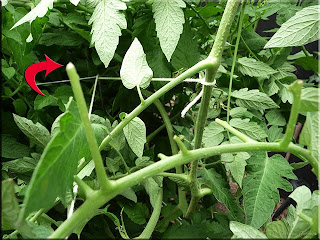There have been several reports of late blight hitting tomato plants in the northeastern US states. Some home gardeners have reported late blight within 100 km of us as well so I have been on high alert watching for any signs. I am be especially careful to remove any damaged vegetation from both the plants and soil level. While I have had minor damage due to the storms that went through so far there have been no signs of late blight. Tomato Hornworm
Tomato Hornworm
This morning as I did my regular tomato vine inspection I noticed what at first appeared to be leaf damage. On closer inspection it turned out to be a tomato hornworm Manduca quinquemaculata (Lepidoptera: Sphingidae). Another check through the vines found another one. This pest is common the the northern US states and southern portions of Canadian provinces. Despite it's rather menacing appearance, the hornworm will not bite you. It feeds only on solanaceous plants, usually the tomato. However the larvae will also feed on eggplant, pepper and potato plants so be sure to check these plants as well.
The adult moth is sometimes referred to as a "sphinx", "hawk", or "hummingbird" moth. This is a large, heavy-bodied moth with narrow front wings and a wing spread of 4 to 5 inches . The moth is a mottled gray-brown color with yellow spots on the sides of the abdomen . The eggs of the tomato hornworm are deposited singly on both the lower and upper surface of leaves in late spring. They oval, smooth, light green to yellow in color measuring 0.10 cm in diameter. They hatch in six to eight days.
Tomato hornworm larvae are pale green with white and black markings. They undergo 5-6 instars. The first instar is yellow to white in color with no markings while other instars develop eight white, lateral V-shaped marks. A black projection or "horn" on the last abdominal segment furthest from the mouth gives the caterpillar the name hornworm. The caterpillar reaches the final instar in 3-4 weeks. It is about 4 inches long when fully mature. The fully-grown larvae then drop off of the plants and burrow into the soil to pupate. During the summer months, moths will emerge from pupae in about 2 weeks. When the moths emerge from the soil they mate, and deposit the eggs of the next generation on tomato plants. By early fall, the pupae remain in the soil where the overwinter emerge as a moth the following spring.
 Tomato Hornworm Damage
Tomato Hornworm Damage
Tomato plants should be checked for hornworms from early July to late August. Unless you see the tomato hornworm you will likely blame missing leaves and stems on tomato plants on rabbits or possibly the wind. On closer inspection you will note that the damage is likely well out of reach of rabbits and lacks the sharp angled cut. The leaves will have been completely eaten away leaving only the secondary stem (red arrow). If you look even closer below the damage on other branches you will see dark green or black droppings and in fact you will likely see these before you see the actual hornworm. Carefully look above the area where you see the droppings. It may take a bit of looking as the hornworm blends in nicely with the tomato foliage. Once you find the hornworm the best way to remove it is to hold a bucket under it then clip the stem of the leaf it is on so damaged leaf, stem and hornworm falls into the bucket. If you find a hornworm that appears to have a lot of white elongated eggs on it, leave it alone. Do not remove it! These are the cocoons of a small braconid wasp, Cotesia congregatus. These parasitic wasps will kill off that hornworm then seek out other hornworms to parasitize. Another important natural enemy is the wasp, Polistes spp. (Hymenoptera: Vespidae) that kills and feeds upon a large proportion of the tomato hornworm larvae. It will also attack cabbage looper and other garden caterpillars. Attracting both wasps to your garden is is a good form of natural pest control that should be enouraged.
Check your plants daily for any further signs of infestation. Controlling the larvae by manual removal before they burrow into the ground will lessen or prevent re-infestation in the spring. In traditional row gardens roto-tilling after harvest will destroy any larvae attempting to pupate. If you are using the square foot gardening method in raised bed, once the tomato vines have been harvested remove your grid and work up the soil with a hand held cultivator. If you are concerned work the soil up again in about a week's time. If you buy tomato plants in the spring check them well for any signs of infestation prior to planting them in your garden.
Happy Gardening!
Garden Gnome
©2006-2009




















It's been a strange summer here in NC for tomatoes. We don't have the blight but our fruit is ripening very slowly.
ReplyDeleteVery good write up on this worm. I'll be on the look out. Haven't had one yet--but it's possible.